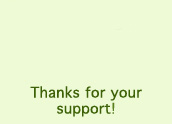1999 Fall Refresher
Reported by Mary Jo Robertson
Who's on first? What's on second? I don't know is on third! This Laurel & Hardy skit is part of the CERT training film and as a first-time member of the volunteer organization, that is exactly where I was on Saturday, October 16 at the Frank Hotchkin Memorial Training Center near Dodger Stadium.
I arrived in Los Angeles approximately 4 1/2 years ago from Toronto, Canada. It was a year after the Northridge Earthquake, so the residents of L.A. were still shaken from that, and I heard a lot of stories of the events that had transpired, the losses, heartaches and shattered nerves. Needless to say I was nervous about living in Southern California. At night I would stack up all the stuff I was told I would need to save myself. I had shoes, clothing, water and money at hand. Time passed and not once did I experience the rumblings of an earthquake. I would hear on the news that there was maybe a 3.2 quake during the night, or friends would ask had I felt that last one, but no, I slept through it all. Time went on, and one year passed on to the next, and still I did not experience an earthquake. I was now becoming pretty complacent about the whole thing. No shoes within easy reach, pants too far away, money, who knows where that was, and water, well there might be one bottle in the fridge. God forbid I should be trapped near my bed! I was no longer ready in the event of a disaster.
Since coming to Los Angeles I have been a member of Neighborhood Watch, and in August 1998 a neighbor told me there would be CERT training at a school in our neighborhood starting in September. At the time I was taking 2 night classes and since this was going to be a 7-week, almost 3 hours each week, training course. My first thought was - No way, I don't have the time! But the more I thought about it, the more I realized that I was living in an area where disaster is inevitable at some stage, so would I find the time, no, but I would make it. The training started and every week I headed off to the school. I was nervous about doing this and joining in, especially alone, but I met some really nice people and seven weeks later I graduated and received a Certificate of Completion from the Fire Department.
Once again, time marched on, no disasters, no earthquakes! Floods and fires raged on in Southern California, but they were not close to where I am, and these disasters are kind
of foreign if you are not in their path. But then every other week the TV would report an earthquake 7.2 in this area, 7.0 over here, a flood plaguing the East Coast. So, I started to realize an
earthquake was inevitable in this area. It was only a matter of time. I was informed that the Fire Department was having its biannual refresher course for CERT-trained people on October 16. I had
missed the spring session, so I would go to this one. However, I really didn't want to go because Saturday and Sunday are my days to take care of stuff for myself, shop, clean, go to a movie. I
sure as hell didn't want to go to an all-day disaster drill that I didn't even know how to get to. Well, all the doubt was gone on October 16th at about 2:54a.m. - the Hector Mine Earthquake - a
7.1 magnitude rocked Southern California. I was lying in bed and first thought my cat had jumped up on the bed, but as movement escalated, I realized upon looking at the foot of the bed, no cat,
this is really an earthquake! I don't need to tell anyone that by 7:00 a.m. I had my helmet, vest, gloves, and lunch and I was ready to head off to the CERT disaster training .
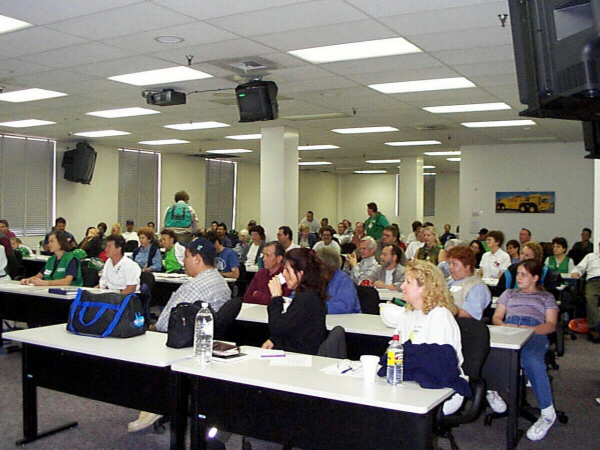 My neighbor and I arrived at the site just about 7:30 a.m. We signed in and went upstairs for our picture ID to be taken, from there we went across the hall and
waited for the day to begin. My neighbor is a member of the ham radio group so I realized that I would be going through this ALONE. I felt nervous and scared. All these people, I don't know
anyone. As I sat there waiting for the day to begin I realized I couldn't remember one thing we had spent 7 weeks -18 hours learning. People started pouring into the room, young and old, men and
women. Finally the morning began, and Captain James Gaffney introduced himself, spoke about the training program, introduced people from the Mayor's Department, from the Fire Department, but the
names and the people were becoming a blur - my nerves were overtaking my brain. We were then told to pair off by number, the time had come, the talking was over, it was now time to show what we
could do.
My neighbor and I arrived at the site just about 7:30 a.m. We signed in and went upstairs for our picture ID to be taken, from there we went across the hall and
waited for the day to begin. My neighbor is a member of the ham radio group so I realized that I would be going through this ALONE. I felt nervous and scared. All these people, I don't know
anyone. As I sat there waiting for the day to begin I realized I couldn't remember one thing we had spent 7 weeks -18 hours learning. People started pouring into the room, young and old, men and
women. Finally the morning began, and Captain James Gaffney introduced himself, spoke about the training program, introduced people from the Mayor's Department, from the Fire Department, but the
names and the people were becoming a blur - my nerves were overtaking my brain. We were then told to pair off by number, the time had come, the talking was over, it was now time to show what we
could do.
Group 5, the group I was assigned to, headed off to Disaster Alley. We headed off to the basement where Firefighter Williams instructed us to pair off with partners and to
choose an Incident Commander. People who had done the drill before suggested that someone who had never been an Incident Commander should be chosen. "How many of you have never been an Incident
Commander?" Reluctantly I put my hand up. Oh, my god, they told me to do it!
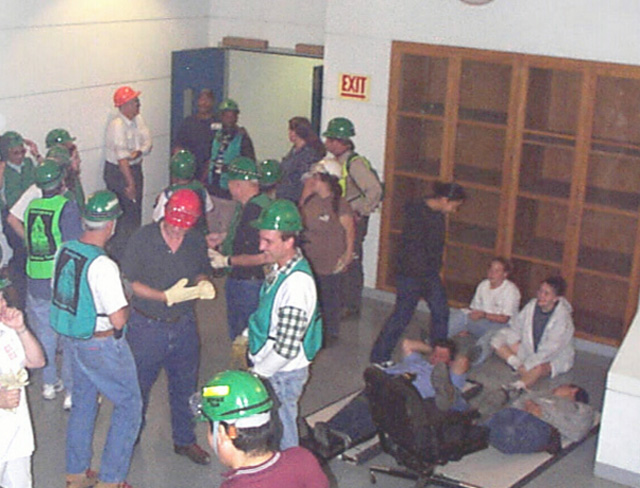 Why didn't I keep my hand down? Well, it was too late. I was the Incident Commander for this drill and I had better get a move on. Choose a scribe. Done. Now, choose
the team leaders, Search and Rescue, Fire, Medical. Done. Then assign the remaining people to the teams. Done. Okay, now we were ready to rescue the 13 people who were victims inside the
building. I tried to remember the training, what does the Incident Commander do - my heart was pounding louder than the activity going on in the room. I heard people yelling, a runner came over
and yelled, Team 1 and Team 2 have gone in - the Scribe wrote this down. There were no fires reported, so the leader of the fire team wanted to go in and assess the situation. We referred him to
the Search and Rescue leader for instructions. At first it was pretty quiet, people were running in and out of the disaster area reporting the findings, the need for other Emergency Services to
be called in and so on, then the casualties started to arrive. More people were going in and out, it was getting more and more difficult to keep track of where everyone was. Finally we had
rescued all of the victims. One person from our Fire team was overlooked in the melee, which really brought home the importance of good training, good record keeping, good communication. This was
hard work and even harder is the realization that if it were real, we would have lost someone, because we didn't know he was missing - lack of communication. I was glad though that I had raised
my hand to be the Incident Commander. This is not a joke and the better trained you are, the greater your help will be in the event of a real disaster.
Why didn't I keep my hand down? Well, it was too late. I was the Incident Commander for this drill and I had better get a move on. Choose a scribe. Done. Now, choose
the team leaders, Search and Rescue, Fire, Medical. Done. Then assign the remaining people to the teams. Done. Okay, now we were ready to rescue the 13 people who were victims inside the
building. I tried to remember the training, what does the Incident Commander do - my heart was pounding louder than the activity going on in the room. I heard people yelling, a runner came over
and yelled, Team 1 and Team 2 have gone in - the Scribe wrote this down. There were no fires reported, so the leader of the fire team wanted to go in and assess the situation. We referred him to
the Search and Rescue leader for instructions. At first it was pretty quiet, people were running in and out of the disaster area reporting the findings, the need for other Emergency Services to
be called in and so on, then the casualties started to arrive. More people were going in and out, it was getting more and more difficult to keep track of where everyone was. Finally we had
rescued all of the victims. One person from our Fire team was overlooked in the melee, which really brought home the importance of good training, good record keeping, good communication. This was
hard work and even harder is the realization that if it were real, we would have lost someone, because we didn't know he was missing - lack of communication. I was glad though that I had raised
my hand to be the Incident Commander. This is not a joke and the better trained you are, the greater your help will be in the event of a real disaster.
Now we were sent upstairs to see a film on a bus disaster and learn through the film to assess R-respiration, P-perfusion, M-mental status. Once we had seen the film we were
sent to lunch and instructed to meet at the south end of the parking lot by the old bus where this film would be re-enacted. By now I realize I have completely forgotten all I know, and I am
still nervous about performing badly in front of all these people. I must try to remember what I am doing. Focus on what is going on.
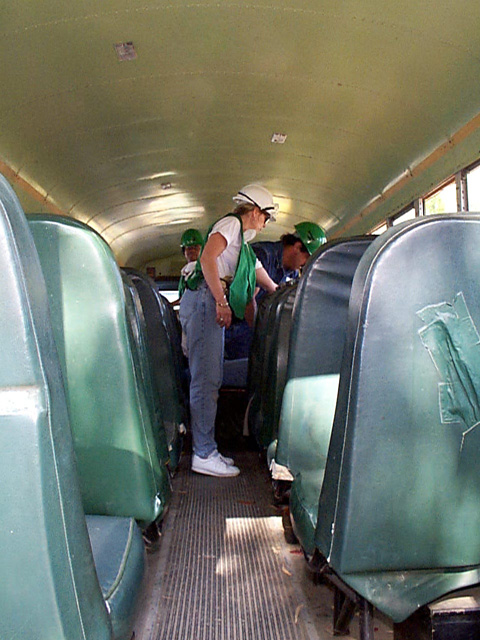 Lunch is over and it is now time to get the afternoon disasters underway. On to the bus we went. At the bus we didn't have any victims- so several of our group
volunteered. We are told to break into 2 teams, the Rescue group and the Medical group. I am now on the Medical team. People seem to be going in every direction. My partner and I are instructed
to check out the walking wounded. We do this and report back to our leader. From the time I started this drill until the end - my mind is totally blank - I have forgotten everything! I keep doing
dumb things. RPM - what is that? speed limit? It is over finally - all aboard the bus have been removed safely. Lucky for the victims the rest of my team members remember what to do. We had a
debriefing with a firefighter who instructed us on our mistakes and the things we have done well. Good thing he didn't see what I was doing. My partner and I were very quiet here. Hope no one
remembers what we did - or actually didn't do!
Lunch is over and it is now time to get the afternoon disasters underway. On to the bus we went. At the bus we didn't have any victims- so several of our group
volunteered. We are told to break into 2 teams, the Rescue group and the Medical group. I am now on the Medical team. People seem to be going in every direction. My partner and I are instructed
to check out the walking wounded. We do this and report back to our leader. From the time I started this drill until the end - my mind is totally blank - I have forgotten everything! I keep doing
dumb things. RPM - what is that? speed limit? It is over finally - all aboard the bus have been removed safely. Lucky for the victims the rest of my team members remember what to do. We had a
debriefing with a firefighter who instructed us on our mistakes and the things we have done well. Good thing he didn't see what I was doing. My partner and I were very quiet here. Hope no one
remembers what we did - or actually didn't do!
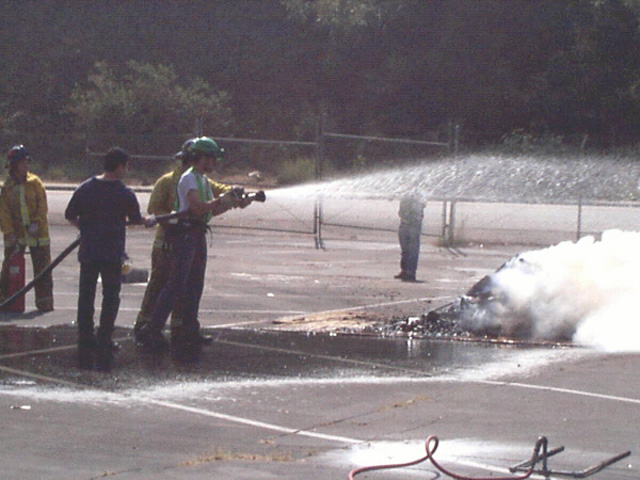 Oh, boy, now we are off to put out a fire. This is good - I like this. I was a fire warden once (but that was a long time ago!). During my training class we had to
use the fire extinguishers and I remembered completely extinguishing FF Newte. He is the leader on the fire drill now - wow maybe I could hose him down again. Several of my group go up, take
their turns, one on the nozzle, one on the hose and one on the water turn-on valve. Now, it is my turn. I am going to be on the nozzle, the instructor has informed us of the pressure in the hose
and that the stance you take is really important so as not to fall over. I am ready. Off we go, but I am not to extinguish anything this time. An anchor from channel 34 wants my partner to stand
on the hose so they can film her and do a bit on Spanish TV about our day. - Hey, no problemo! And lucky for Firefighter Newte too, I might add. Ready! screams my partner, now slowly I turn on
the water, it must be turned slowly, I can't slam it on full blast or my partner may go farther than the water. Slowly the water is filling the pipe, crawling towards the end of the nozzle to fan
out in a magnificent stream over the fire. Out she goes. This part of our drill was managed by my partners and myself with exceptional skill, and my partner got her 15 minutes of fame (well maybe
15 seconds) on Channel 34 on the end of the hose line.
Oh, boy, now we are off to put out a fire. This is good - I like this. I was a fire warden once (but that was a long time ago!). During my training class we had to
use the fire extinguishers and I remembered completely extinguishing FF Newte. He is the leader on the fire drill now - wow maybe I could hose him down again. Several of my group go up, take
their turns, one on the nozzle, one on the hose and one on the water turn-on valve. Now, it is my turn. I am going to be on the nozzle, the instructor has informed us of the pressure in the hose
and that the stance you take is really important so as not to fall over. I am ready. Off we go, but I am not to extinguish anything this time. An anchor from channel 34 wants my partner to stand
on the hose so they can film her and do a bit on Spanish TV about our day. - Hey, no problemo! And lucky for Firefighter Newte too, I might add. Ready! screams my partner, now slowly I turn on
the water, it must be turned slowly, I can't slam it on full blast or my partner may go farther than the water. Slowly the water is filling the pipe, crawling towards the end of the nozzle to fan
out in a magnificent stream over the fire. Out she goes. This part of our drill was managed by my partners and myself with exceptional skill, and my partner got her 15 minutes of fame (well maybe
15 seconds) on Channel 34 on the end of the hose line.
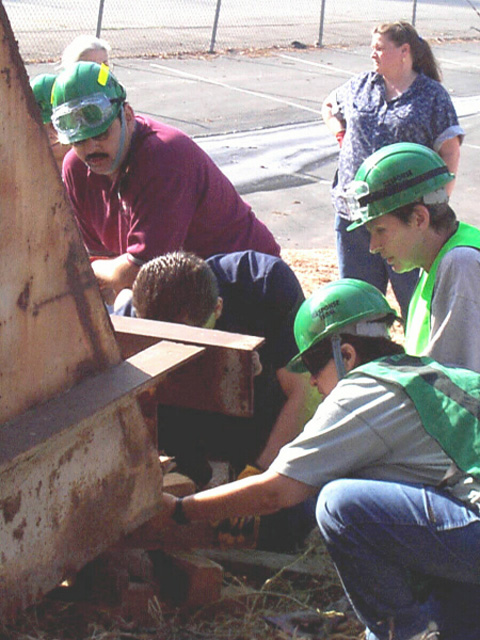 The day is winding down and our last drill is to raise what looks like the top of a cement mixer. This feat is done by a method called cribbing - you start building a
crib under each corner while a person in the middle lifts it. This is a slow process but extremely effective. One group started inserting 2x4's, 4x4's, and a wedge, whatever is needed to raise
the platform and keep it up - steady and even. Slowly the groups were moving along. Ready! Lift! Slide in the 2x4's. Wedge in! Wedge In! Lower! This went on until the cement mixer was about a
foot, foot and a half off the ground. It was quite well raised and pretty solid, at least that was what the firefighters said. Now, the instructions are to lower this baby. It is apparently
tougher to lower it than to raise. Why can't we leave it there? Okay, okay, we'll lower it. Ready! Ready! Wedge in! Wedge in! Lower! One by one we removed the wood pieces, slid in a wedge, until
we had managed to plant the cement mixer back on the ground. Having completed this, we were instructed to go back to the classroom.
The day is winding down and our last drill is to raise what looks like the top of a cement mixer. This feat is done by a method called cribbing - you start building a
crib under each corner while a person in the middle lifts it. This is a slow process but extremely effective. One group started inserting 2x4's, 4x4's, and a wedge, whatever is needed to raise
the platform and keep it up - steady and even. Slowly the groups were moving along. Ready! Lift! Slide in the 2x4's. Wedge in! Wedge In! Lower! This went on until the cement mixer was about a
foot, foot and a half off the ground. It was quite well raised and pretty solid, at least that was what the firefighters said. Now, the instructions are to lower this baby. It is apparently
tougher to lower it than to raise. Why can't we leave it there? Okay, okay, we'll lower it. Ready! Ready! Wedge in! Wedge in! Lower! One by one we removed the wood pieces, slid in a wedge, until
we had managed to plant the cement mixer back on the ground. Having completed this, we were instructed to go back to the classroom.
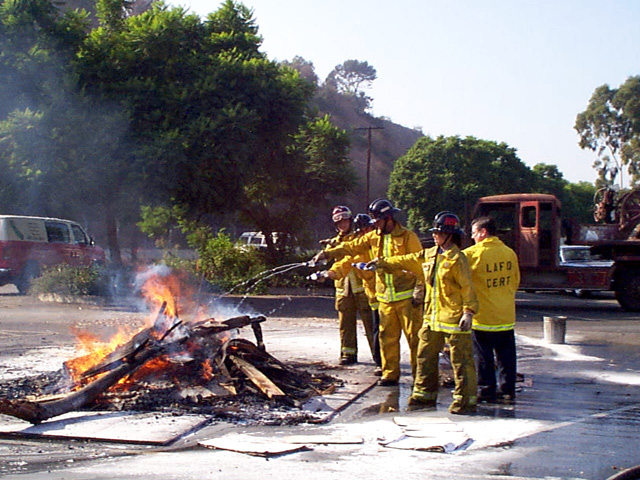 The day was almost over! The fire cadets were starting to burn all the scrap wood . I guess this is how firefighters celebrate a good day's work. We all filed back to
the room. We met all the cadets who are learning a tough job and are becoming excellent citizens.
The day was almost over! The fire cadets were starting to burn all the scrap wood . I guess this is how firefighters celebrate a good day's work. We all filed back to
the room. We met all the cadets who are learning a tough job and are becoming excellent citizens.
Through all my nervousness, dumb moves, memory loss, this was an incredible day. It taught me how much I really don't know and still must learn and must participate in these
training exercises. I feel very proud to be part of this volunteer organization and am in awe of the men and women who gave up their Saturday to train us to be a part of this group. I really hope
that we will never be called upon to use our skills, but if we are I know that there are some incredible people out there.
See you in the spring!




